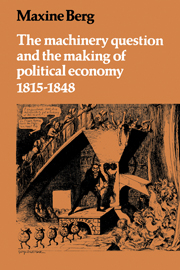Book contents
- Frontmatter
- Contents
- List of Illustrations
- Preface
- Introduction
- PART ONE THE MACHINERY QUESTION
- PART TWO THE POLITICAL ECONOMY OF MACHINERY
- 4 Ricardo's chapter
- 5 Political economy and the division of labour
- 6 Political economy and capital
- PART THREE A SCIENCE OF MACHINERY
- PART FOUR THE POLITICS OF MACHINERY
- PART FIVE THE SOCIAL CRITICS OF MACHINERY
- EPILOGUE: BEYOND MACHINERY
- Bibliography
- Index
5 - Political economy and the division of labour
Published online by Cambridge University Press: 29 January 2010
- Frontmatter
- Contents
- List of Illustrations
- Preface
- Introduction
- PART ONE THE MACHINERY QUESTION
- PART TWO THE POLITICAL ECONOMY OF MACHINERY
- 4 Ricardo's chapter
- 5 Political economy and the division of labour
- 6 Political economy and capital
- PART THREE A SCIENCE OF MACHINERY
- PART FOUR THE POLITICS OF MACHINERY
- PART FIVE THE SOCIAL CRITICS OF MACHINERY
- EPILOGUE: BEYOND MACHINERY
- Bibliography
- Index
Summary
Ricardo's novel analysis of the machinery issue provoked not only his critics but his closest followers. The latter were often more interested in the practical implications of the conclusion of his chapter on machinery than they were in the novelty of the theoretical analysis. The chapter on machinery obviously opened deep social concerns among Ricardo's contemporaries. His new ideas rankled, for they sharpened a source of contention already apparent in working-class dissent from industrialisation. Owenism and anti-machinery riots had by now become very real bogies for the optimists of early nineteenth-century industrial capitalism. In the years following Ricardo's death much of the new work in political economy which addressed itself to the future economic prospects of Britain projected a certain polemical tone. It was a polemic incorporated in a purposive inquiry into the universal benefits of industrialisation. Political economists conducted their inquiries into the benefits of industrialisation against the background of both the theoretical heritage of Smith and Ricardo and the practical issues of crisis and depression, Owenite radicalism, and resistance to machinery that flared up in the anti-machinery riots of 1826. It was the response to Ricardo's legacy plus such pressing issues of economic policy which made political economy a discordant though exploratory discipline in the 1820s.
Economists after Ricardo faced many difficulties in coming to terms with his Principles which even in his own time was an intellectual tour dc force. Not least among these difficulties was the problem of understanding the status of and the relationship between his twin interests in the analysis of the falling rate of profit and the optimistic growth prospects of Western economies.
- Type
- Chapter
- Information
- Publisher: Cambridge University PressPrint publication year: 1980



